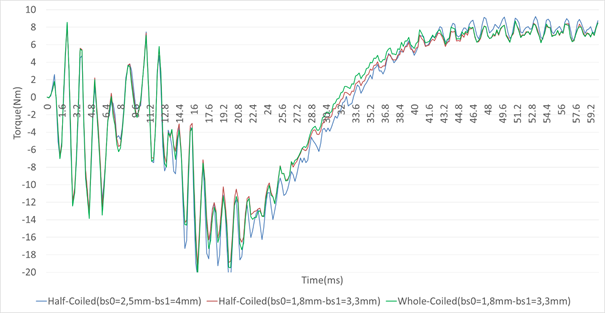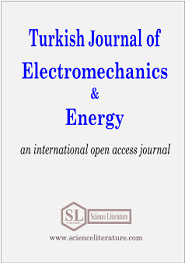
Investigation of the efficiency improvement on a 1.1 kW three-phase asynchronous motor
Abstract
In this study, the geometrical dimensions of the operational motor parameters of a three-phase squirrel-cage asynchronous motor were obtained by disassembling it. Operating parameter values and properties of the asynchronous motor were measured and modelled using the Ansys RMxprt tool box. The modelling results and efficiency values were found within 0.3% of the ratings on the motor nameplate. The parameter values (e.g. torque, break-down torque, locked rotor current) obtained from modelling were compared to those on the motor nameplate values. In this model, both the finite element and analytical methods were performed successfully. In this study, only the stator parameters of asynchronous motor are analysed and optimized using motor design equations. The rotor structure has been kept the same during the study. The stator slot parameters were changed over certain intervals for more efficient operation. With these analyses, motor torque, power, efficiency, and stator–rotor magnetic flux values were examined. As a result of these works, the efficiency of the motor was increased by 1.59% and the power factor was enhanced by using the optimal slot parameters and whole-coil stator windings. With the changes made to the stator slot parameters and the type of stator winding, the motor efficiency class has been increased from IE2 to IE3. According to the European Union, the production of motors of the lowest efficiency class is IE3, and lower than this class production is forbidden as of July 1, 2021. It means that the IE2 class motors must be converted into the IE3 class motors. This study presents a simple, fast, and effective way to increase motor efficiency class for the transient operating region of the motor in detail.
Full Text:
PDFReferences
P. Waide and C.U. Brunner, “Energy-Efficiency Policy Opportunities for Electric Motor-Driven Systems,” International Energy Agency Working Paper, Energy Efficiency Series; International Energy Agency: Paris, France, 2011, p 132.
G. Lei, J. G. Zhu and Y.G. Guo, Multidisciplinary Design Optimization Methods for Electrical Machines and Drive Systems, Springer-Verlag, Berlin/Heidelberg, Germany, 2016.
V. Goman, V. Prakht, V. Kazakbaev and V. Dmitrievskii, “Comparative Study of Induction Motors of IE2, IE3 and IE4 Efficiency Classes in Pump Applications Taking into Account CO2 Emission Intensity,” Applied Sciences, 10(23):8536, pp.1-10, 2020.
M. Jannati, S. A Anbaran, S. HesamAsgari, W. Y. Goh, A. Monadi, M. J. A. Aziz and N. R. NikIdris, “A review on Variable Speed Control Techniques for Efficient Control of Single-Phase Induction Motors”, Evolution, classification, comparison Renewable and Sustainable Energy Reviews, vol.75, pp. 1306-1319, August 2017.
I. Sarıgul and M. Ozdemir, “Comparative Analysis of Six Phase Induction Motor”, European Journal of Technique (EJT), 11(2), pp. 234-238, 2021.
W. Schuuisky, I. Cetin, Elektrik Motörleri 1. kısım, Istanbul, Fatih Yayınevi, 1987, p 304.
A. G. Yetgin, “The Effect of Induction Motor Shaft Diameter on Motor Performance”, Sakarya University Journal of Science, 21(4), pp.604-608, 2017.
A. Cetin, Z. Demir and N. Colak, “Elektrik Motorları Verimlilik Analizi ve Porsuk MYO Örneği,” Elektronik Mesleki Gelişim ve Araştırmalar Dergisi, 4(1), pp. 15-21, 2016.
IEC 60034-30-1 “Rotating electrical machines Part 30: Efficiency classes of single-speed,” three-phase, cage-induction motors (IE code), BSI Stand, Available: https://www.en-standard.eu. [Accessed: February 20, 2022].
T.C. Resmi Gazete, Elektrik motorlarının ve değişken hız sürücülerinin çevreye duyarlı tasarım gerekliliklerine dair tebliğ, 28 Nisan 2021. [Online]. Available: https://www.resmigazete.gov.tr/eskiler/2021/04/20210428-2.htm [Accessed: February 20, 2022].
S. Şal and L. T. Ergene, “Analysis of the Rotor Bar Geometry’s Effect on the Induction Motor Performance with Finite Element Method,” National Conference on Electrical, Electronics and Computer Engineering, 02-05 December 2010, Bursa, Turkey.
J. H. Lee, J. W. Kim, Y. and H. Kim, “Optimum Design Criteria for Premium Performance of Traction Induction Motor”, 9th IET International Conference on Computation in Electromagnetics, 31 March- 1 April 2014, London, UK [Online]. Available: IET Digital Library, https://digital-library.theiet.org/content/conferences/10.1049/cp.2014.0223 [Accessed: February 20. 2022].
E. C. Abunike, O. I. Okoro and G. D. Umoh, “Steady and Dynamic States Analysis of Induction Motor: FEA approach,” Nigerian Journal of Technology (NIJOTECH), 36(4), pp.1202-1207, 2017.
S. Arslan, “Performance Comparison of Submersible Motor Based on Numerical and Analytical Results,” Düzce University Journal of Science and Technology, 4(2), pp. 403-415, 2016.
B. Gecer, O. Tosun, H. Apaydin and N. F. O. Serteller, “Comparative Analysis of SRM, BLDC and Induction Motor Using ANSYS/Maxwell,” 2021 International Conference on Electrical, Computer, Communications and Mechatronics Engineering (ICECCME), 07-08 October 2021, Mauritius, Mauritius [Online] Available: IEEE Xplore, https://ieeexplore.ieee.org/stamp/stamp.jsp?tp=&arnumber=9591010, [Accessed: 10 April. 2022].
K. B. Baltzis, “The Finite Element Method Magnetics (FEMM) Freeware Package: May It Serve as an Educational Tool in Teaching Electromagnetics?”, Education and Information Technologies, 15(1), pp.19-36, 2010.
P. Ravi, J. Mohamad, R. K. Behera. and S. K. Parida, “Design of a Three Phase Squirrel Cage Induction Motor for Electric Propulsion System,” IFAC Proceedings Volumes, 47(1), pp.801-806, 2014.
S. Gao and Y. Cai, “Design and Simulation of Flux Identification Based on RBF Neural Network for Induction Motor,” IEEE International Conference on Computer Application and System Modelling, 22-24 October 2010, Taiyuan, China [Online]. Available: IEEE Xplore, https://ieeexplore.ieee.org/stamp/stamp.jsp?tp=&arnumber=5619405, [Accessed: 10 April. 2022].
S. Z. Partal, A. Cayıroğlu, M. Kılınç and U. Y. Gündoğar, “IE4 Verimlilik Sınıfına Ulaşmak İçin Toroidal Sargılı Asenkron Motorun Tasarım Optimizasyonu,” European Journal of Science and Technology (EJOSAT), (35), pp.177-186, May 2022.
Y. Aybeniz, K. N. Bekiroğlu, A. F. Keskin, A. H. Obdan and A. Y. Arabul, “IE3 Verim Sınıfındaki 5,5 kW Gücünde Asenkron Motorun IE4 Verim Sınıfına Yükseltilmesine Yönelik Tasarım İyileştirmeleri,” European Journal of Science and Technology (EJOSAT), (35), pp.133-141, May 2022.
G. Lei, J. Zhu, Y. Guo, C. Liu and B. Ma, A Review of Design Optimization Methods for Electrical Machines,” Energies, 10(12):1962, pp.1-31, 2017.
A. Karabiber and M. Çelebi, “Asenkron Motor Tasarımının Güncellenmiş Kriterler ile Simülasyonu”, Fırat Elektrik-Elektronik ve Bilgisayar Sempozyomu, FEEB'11, 5-7 Ekim 2011, Elazığ, Türkiye, pp. 321-325, 2011.
M. Tumbek, Y. Oner and S. K. Çoramık, “Optimal Design of Induction Motor with Multi-Parameter by FEM Method,” 9th International Conference on Electrical and Electronics Engineering, ELECO, 26-28 November 2015, Bursa, Turkey, [Online]. Available: IEEE Xplore, https://ieeexplore.ieee.org/stamp/stamp.jsp?tp=&arnumber=7394483, [Accessed: 11 April. 2022].
S. Kul, O. Bilgin and M. Mutluer, “Application of Finite Element Method to Determine the Performances of the Line Start Permanent Magnet Synchronous Motor”, Procedia-Social and Behavioral Sciences, vol. 195, pp. 2586-2591, July 2015.
O. Gurdal, Elektrik Makinalarının Tasarımı, Bursa, Bursa Orhangazi University publication, 2015, p. 535.
URN: https://sloi.org/urn:sl:tjoee72230
Copyright (c) 2022 Turkish Journal of Electromechanics and Energy

This work is licensed under a Creative Commons Attribution-NonCommercial 4.0 International License.

 Indexed in:
Indexed in:
















